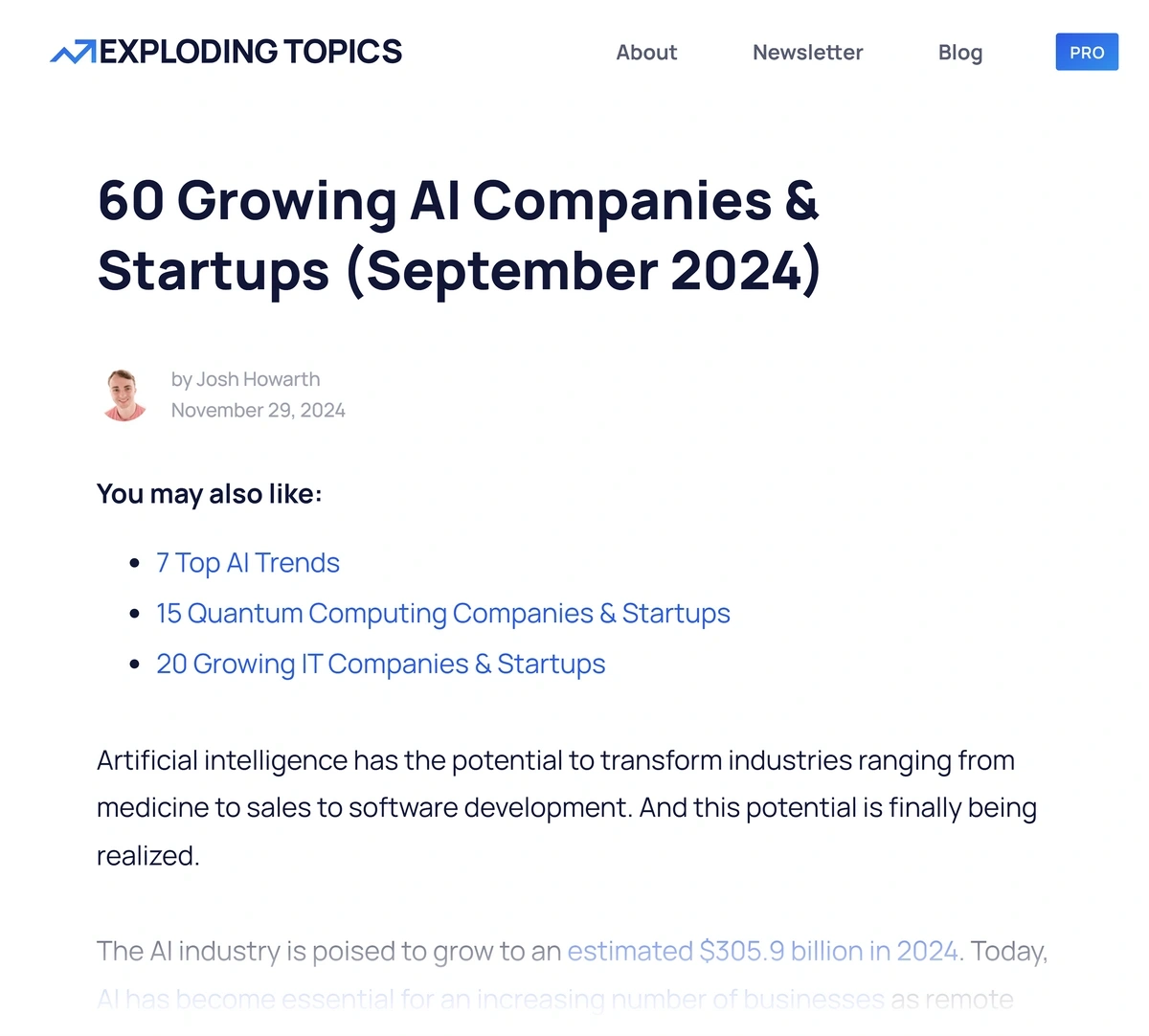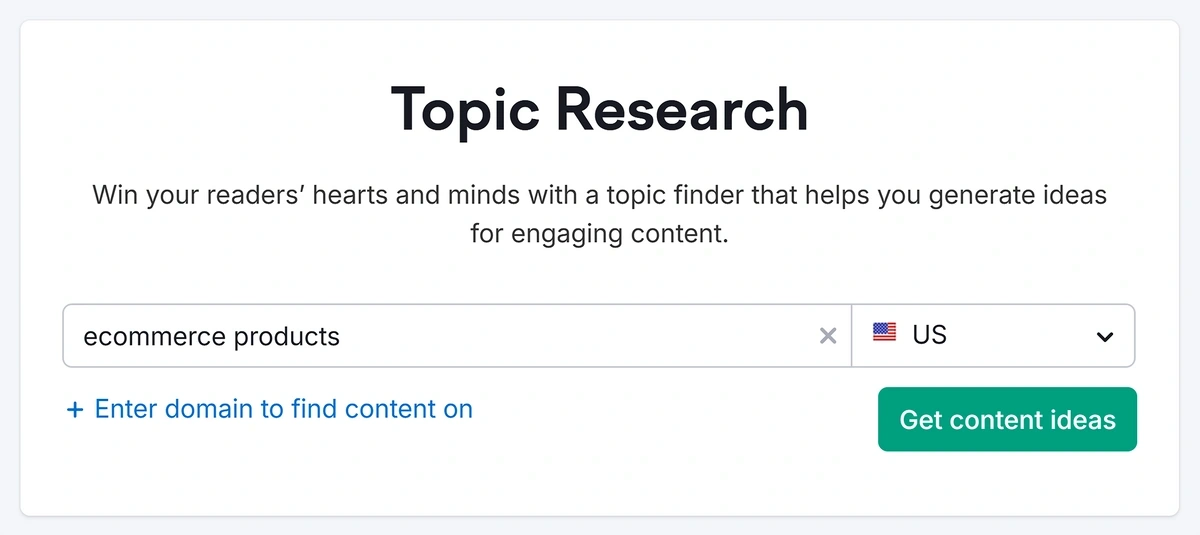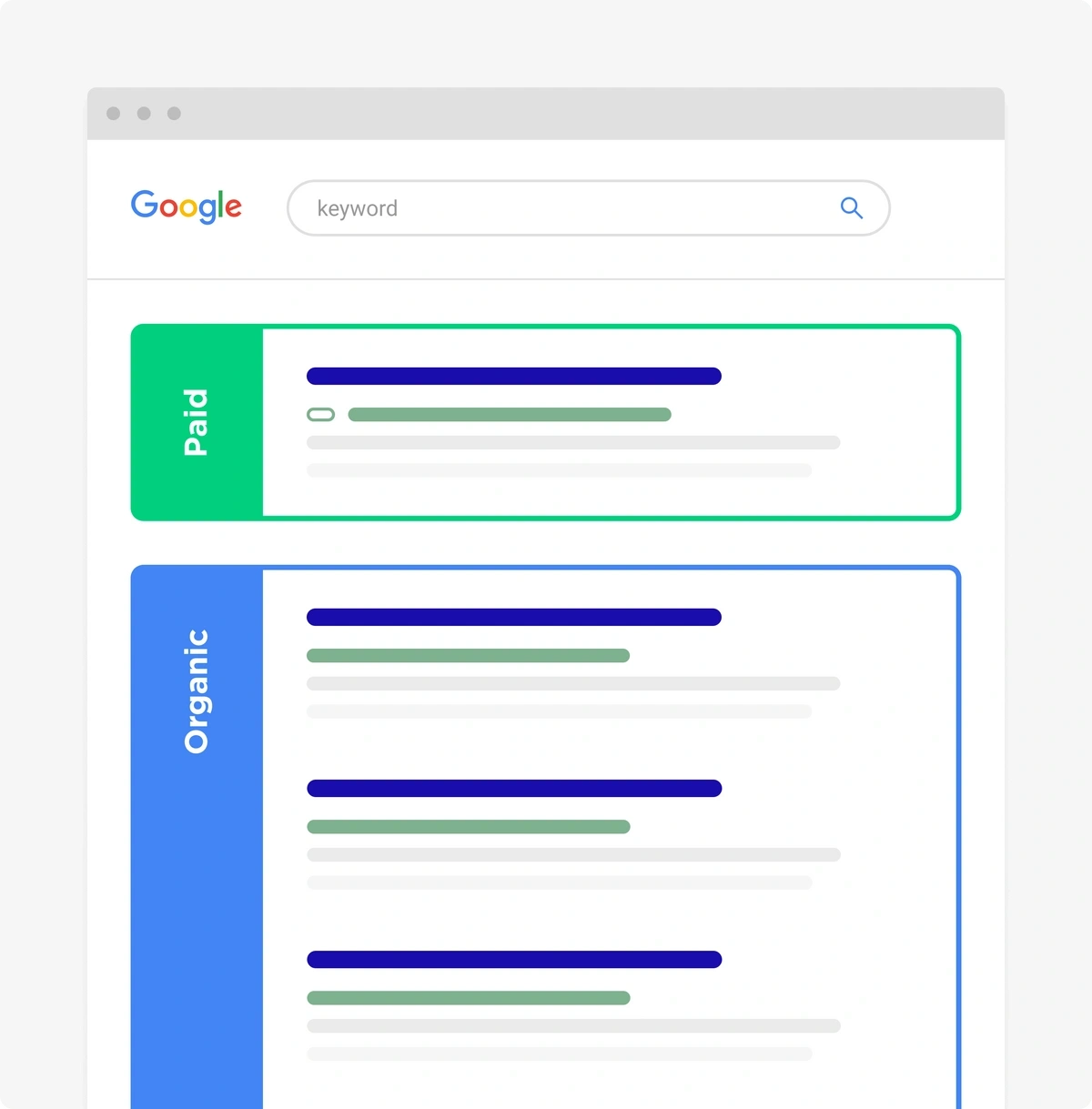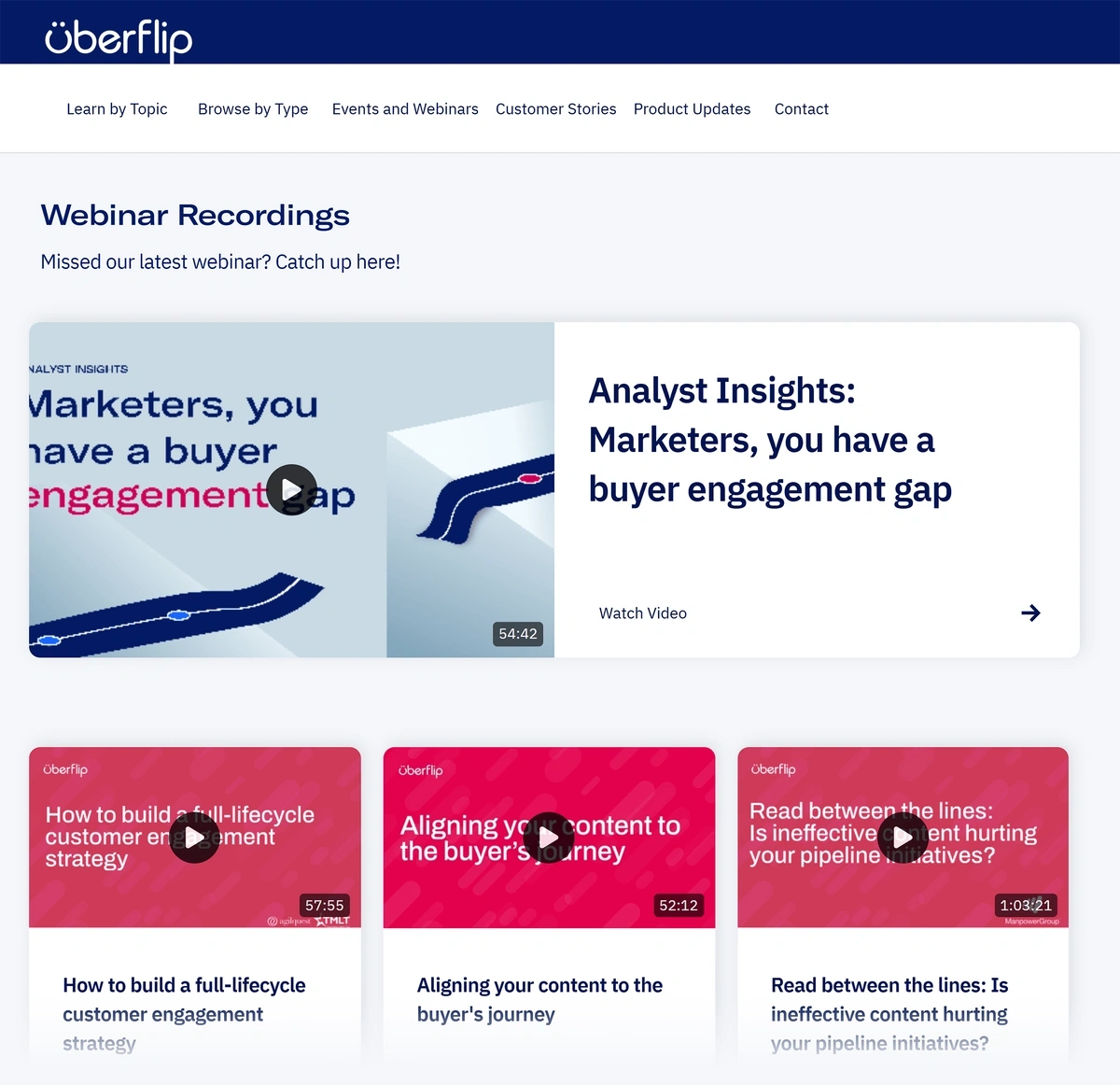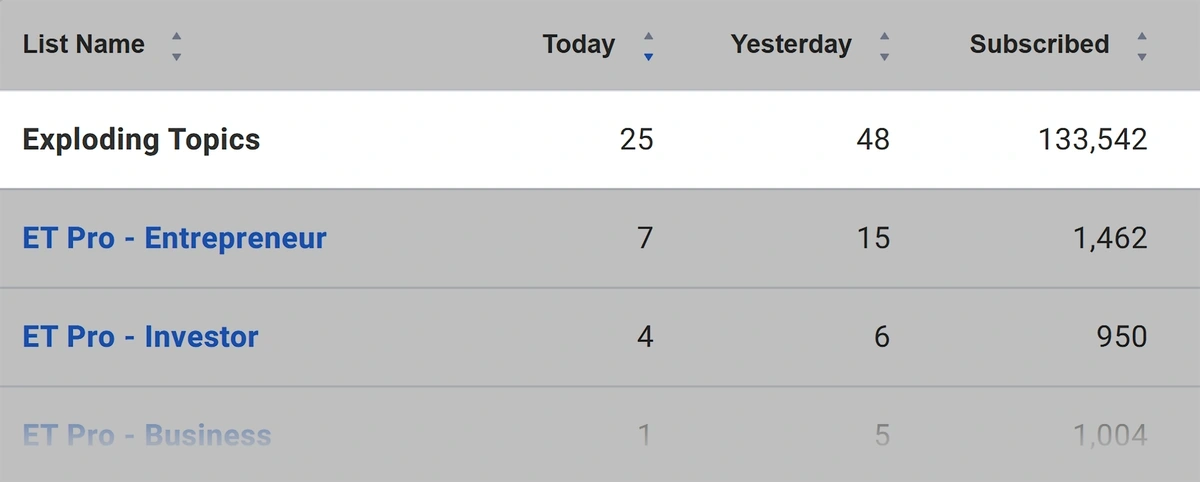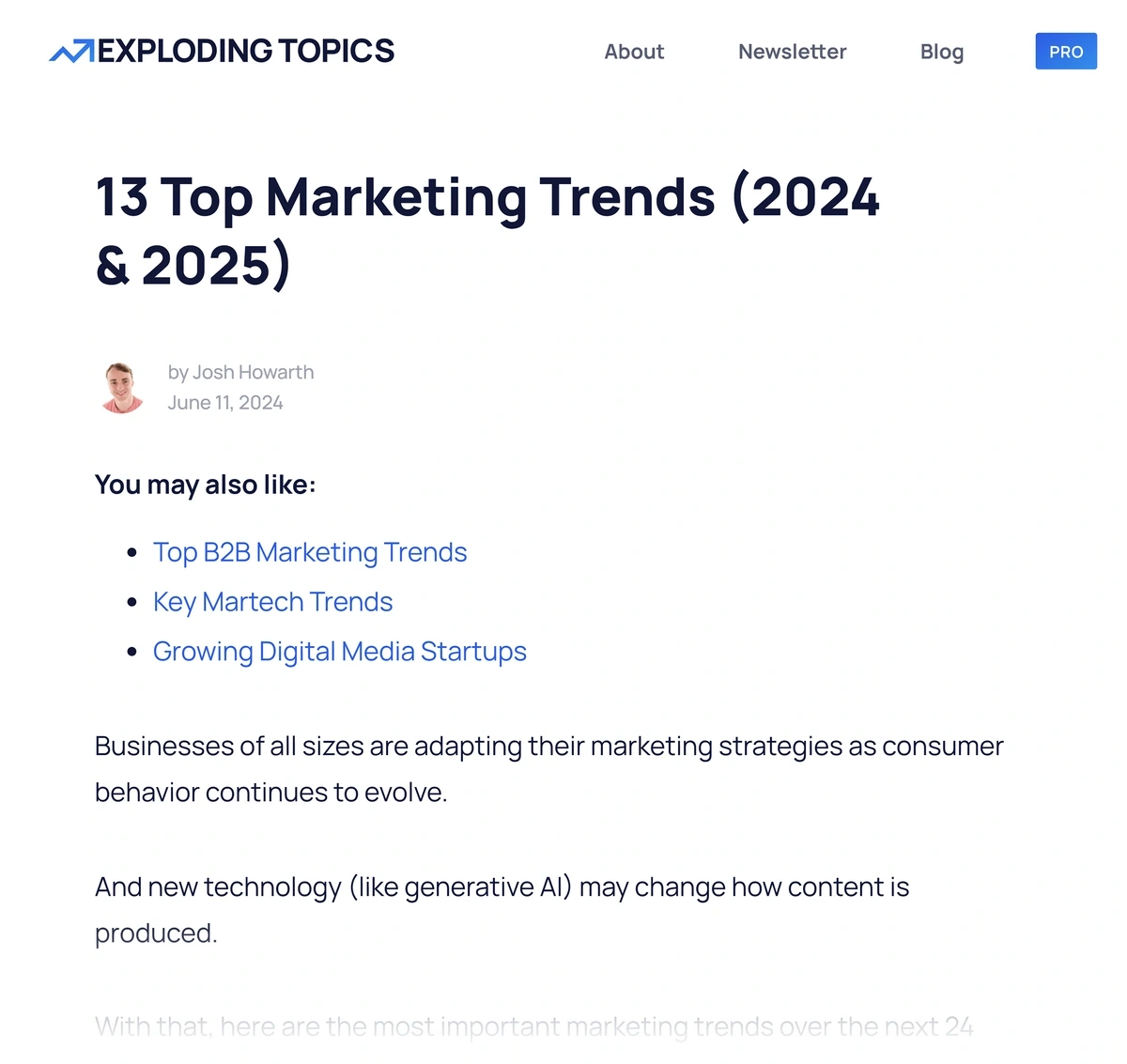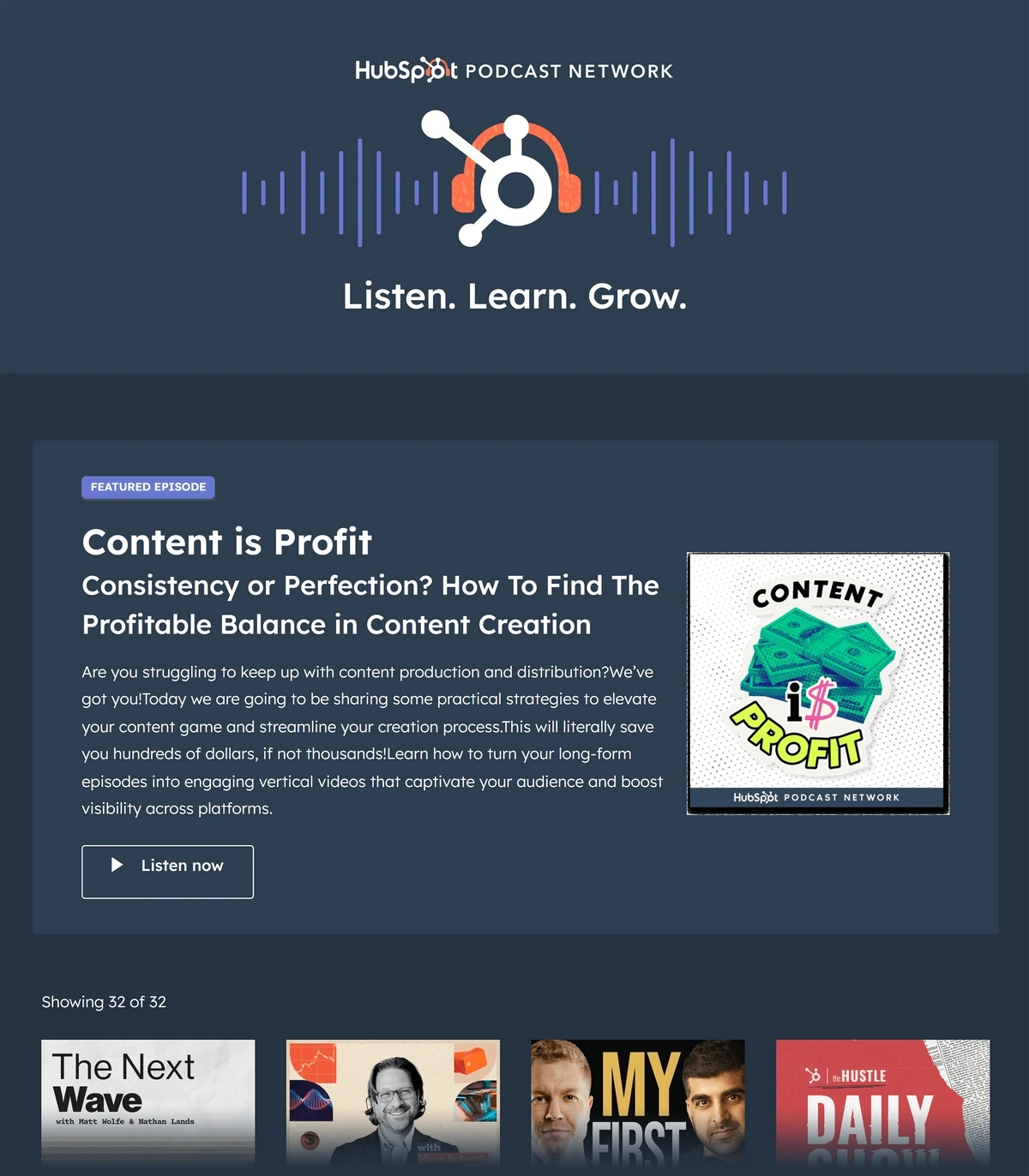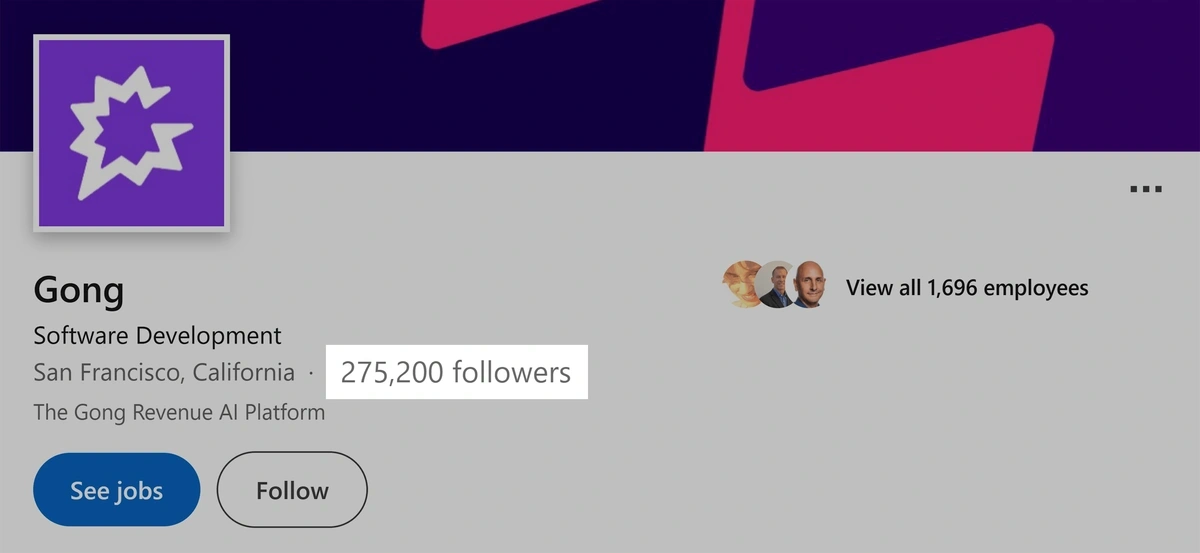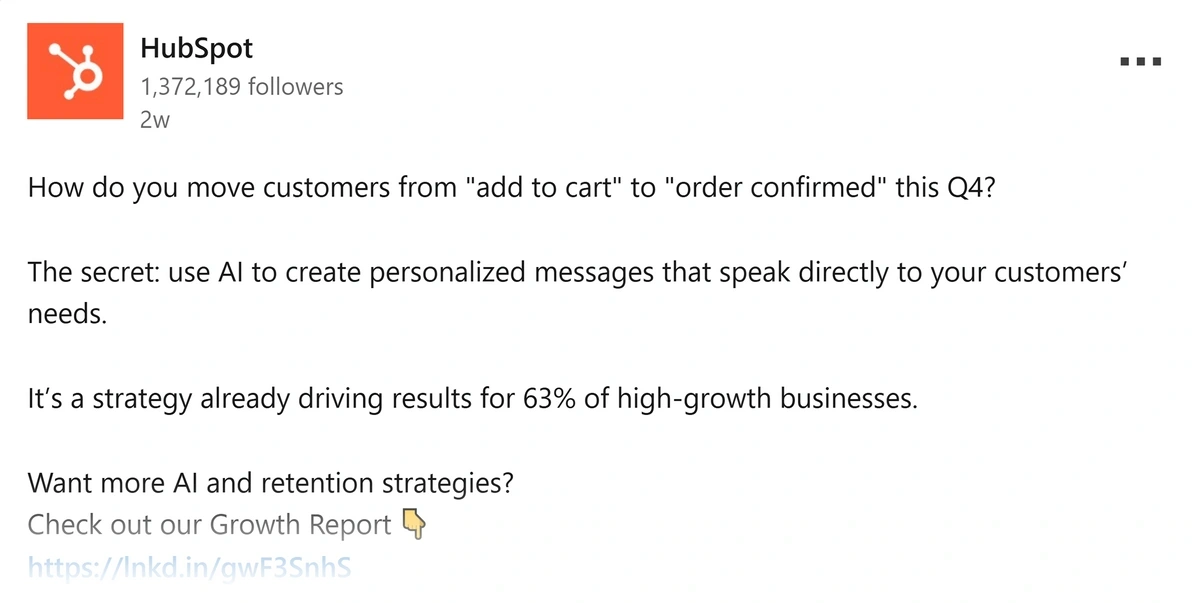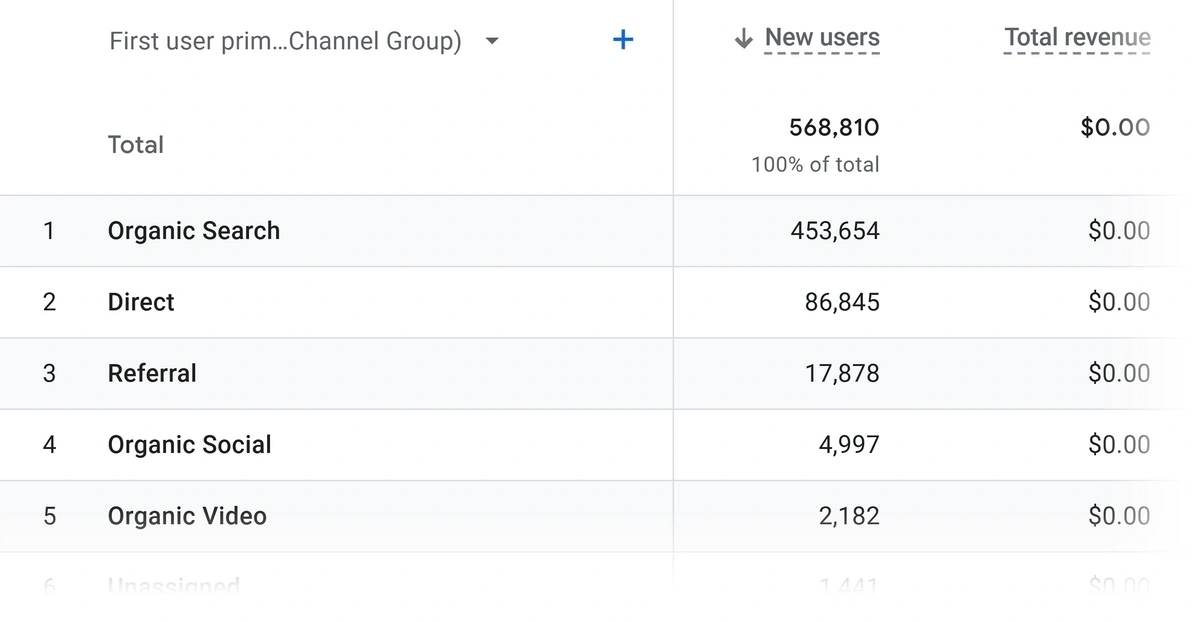
Content Marketing for SaaS: How to Do It Right (2025)
In this post you’ll see the SaaS content marketing approach we used to get over 600K visitors per month:
Over 100,000 email subscribers:
And thousands of social media followers:
Let’s dive right in.
Step #1: Identify Your Ideal Customer Groups
Your first step is to identify the BEST customer groups for your SaaS product.
That way, you tailor your topics, content, and voice to that exact group.
In our case, our SaaS is a trend-spotting tool called Exploding Topics.
When we first got serious with content marketing, we had around 200 paying customers.
So the first thing we did was export a list of our top-paying customers from Stripe.
(Basically, customers that were on an expensive plan for a long period of time).
We then intensely researched each of the top customers, including:
- Where they lived (country and state)
- Where they worked
- Their past and current roles
- Approximate age, gender and other high-level demographic info
As you can see, this is more than just creating customer personas.
We literally looked at the individual buyers of our SaaS.
(We’re in B2B SaaS. So some people sign up directly. Others were part of a larger organization. Either way, we wanted to know WHO was signing up and paying us each and every month).
From that, we identified four core groups of customers:
- VCs/Investors: Specifically, analysts and junior-level staff in mid-size VC firms.
- Ecommerce companies: Larger retailers (Fortune 500) as well as businesses that run several ecom brands.
- Publishers: Publishers that own several properties generating at least 2M visitors/mo in traffic.
- Marketers: SEO agencies and “creative agencies” (ie. making video content for brands).
Once you have at least one customer group, it’s time to start coming up with topics.
Step #2: Brainstorm Topics
If you’ve been in business for a while, you probably already know of at least a few topics that your customers are interested in.
For example, we knew that our customer group of VCs would want to see startups in different industries that were trending.
So we quickly created 50+ lists of trending startups in industries like SaaS, DTC and AI:
And it was the same story with our group of ecommerce customers.
What did they want to see? Products that were trending.
And how about marketers? They wanted to see what was trending on platforms like YouTube and TikTok:
If you’re stuck.
Or just want some ideas.
Here are a few ways to find topics that your target customers are interested in:
Semrush
Semrush’s platform has a dedicated feature called Topic Research.
This feature is specifically designed to help you find content topics to write about.
And it’s especially good at this stage (topic ideation/brainstorming).
For example, one of our target customer groups are ecommerce sellers.
So I typed in “ecommerce products” into the tool.
And within a few seconds, I got a number of topics related to “ecommerce products”.
It’s important to note that you’re really just brainstorming here.
(NOT coming up with specific keywords/topics).
As you can see, some of the topics Topic Research suggested were very closely related to my keyword.
While others were more tangentially related:
Either way, when you click on a topic card, it expands to show you examples of existing content:
Which can also help you brainstorm potential topic ideas that would be hard to come up with on your own.
ChatGPT
AI tools like ChatGPT are GREAT for this brainstorming stage.
That’s because they will often come up with topic ideas that you may not have thought of on your own.
Here’s an example from our SaaS:
We thought of some of these topics already.
But the suggestion about Investor Pitch Preparation was interesting.
We also didn’t think of writing about Economic and Policy Impact on Emerging Sectors.
All of these suggestions from ChatGPT could work really well as blog topics.
That’s why I consider using LLMs a key step in the early stages of topic generation.
Customer Calls
If you have at least one customer, customer calls are a GOLDMINE of topic ideas.
With tools, you’re kind of guessing what your target customers search for.
But when you talk to customers, they’ll literally tell you their problems, issues and strategies.
For example, I had a customer call with an investor customer a few months ago…
And they mentioned they found our SaaS when searching for “alternative data solutions”.
Alternative data isn’t a topic we ever considered.
But considering we provide unique trend data that’s valuable for investors, it makes sense that we’d be considered an alternative data provider.
So we got to work creating blog posts about alternative data.
Including high-level content about the alternative data market as a whole:
And more granular content about how to use alternative data to make investment decisions:
This content (along with others that we published around the same time), is one of the main ways that we generate over 1,000 trials per month.
Here are some questions to ask during customer calls that can help you find EXCELLENT topic ideas:
- “Do you remember what you searched for to find us?”
- “What tools are you currently using to help with your problem?”
- “If you were to describe your use case in one sentence, what would it be?”
- “What features would you consider most important to solving your problem?”
- “If you could wave a magic wand, what would a solution look like to you?”
- “Have you tried using Google to find a solution before? Do you remember what you searched for?”
Want to Spy on Your Competition?
Explore competitors’ website traffic stats, discover growth points, and expand your market share.
Step #3: Refine Topics and Keywords
Now it’s time to turn your topic ideas into hyper-specific keywords.
That way, you can make sure you’re covering topics that:
- Customers are definitely interested in
- Have a chance to be found and discovered by customers
For example, when we first started ramping up the Exploding Topics blog, we targeted VERY specific topics like:
- “Supply chain trends”
- “Edtech startups”
- “Cloud Computing Stats”
And these targeted topic helped our site’s traffic grow consistently over time:
If we focused on broader topics (like “technology trends” or “marketing stats”) at first, we wouldn’t have done nearly as well.
Why?
Because those broad topics are way too competitive.
Here’s how to find highly specific, low-competition topics.
First, head over to the Keyword Magic Tool inside of Semrush:
Then, enter a topic idea that you came up with in step #2.
And you’ll get a large list of keywords that are directly related to that topic.
As you browse the list, you’ll want to keep an eye out for a few things:
Volume
This is the number of people that search for that exact term every month in the country you selected.
But in general, you want keywords with higher search volume vs. those with low search volume.
That said, I wouldn’t obsess about search volume.
If you’re just starting out with SEO and content marketing, just make sure that SOME people are searching for that keyword.
I sometimes literally target keywords with 50 searches per month if it’s something that will bring in leads and sales.
For example, we published a post about trends in the podcasting space.
According to Semrush, this keyword only gets 90 searches in the US each month:
But it’s a topic that our target customers would be VERY interested in. So we published it.
And it’s brought in countless leads over the last few years.
Thanks largely to the fact that the post ranks #1 in Google:
KD%
Keyword Difficulty percentage (KD%) is an estimate of how hard it will be to rank a piece of content about that topic in Google search.
If your SaaS startup is new to SEO, you want to target keywords with a low KD%.
For example, we targeted the keyword “alternative data providers” with this blog post:
This keyword has a KD% of 13%. Which means that it will be relatively easy to rank for in Google.
As it turned out, we were able to crack the top 3 of Google for that term within about a month of that post going live:
(A position we’ve held ever since).
When you target low KD% keywords, you can get some quick wins early on.
And as your site’s authority and audience grows, you can gradually target keywords with higher and higher KD%.
CPC
CPC is short for “cost per click”.
CPC represents how much businesses are currently paying to advertise for that specific keyword.
(Specifically, the amount they pay whenever a user to clicks on their ad).
The more someone is willing to pay for a click, the more likely it is that searcher is ready to buy something.
(Or at least sign up as a lead or trial user).
For example, take the keyword we currently rank on the first page of Google for “fastest growing cities in america”.
This keyword has a CPC of only $.43.
Which makes sense. Someone searching for the top-growing cities in the US is doing general research. They’re not looking for a solution to a specific problem.
In fact, this keyword is so broad that lots of people that search for this term may not be in our target audience.
On the other hand, we also rank for the term “ai startup companies”.
This keyword is a bit more targeted. So it’s CPC is over $3.
And if we look at a super targeted keyword like “top market research companies”, it has a CPC of $9.49.
In general, you want to choose keywords with higher CPCs.
That way, the traffic that you get ultimately leads to actual customer and MRR growth.
Product Fit
The other factor to consider when choosing keywords is how likely it someone searching for this going to make a purchase.
CPC can help you estimate this.
But you know your SaaS company better than anyone.
So you’re in a unique position to determine whether a keyword is something that your target customers search for.
For example, we know that many of our Exploding Topics customers use us as an alternative to Google Trends.
So when we saw the keyword “Google Trends Alternatives”, it was a no brainer to go for it.
It didn’t hurt that the keyword had a very low KD% and a CPC of over $3.
Step #4: Choose Your “Base” Format
Now that you have a keyword, what’s next?
Choosing the “base” format for your content.
The base format is the first piece of content you’ll produce around that topic.
From there, you can then repurpose and reuse that content in other formats.
For example, blog posts are the base format for the vast majority of our content.
We then repurpose our blog content into other formats, like YouTube videos:
And posts on X:
With that, here are a few formats that tend to work best for SaaS content marketing:
Blog Posts
Blog posts are a great base format for most SaaS companies.
(Especially B2B SaaS)
Why?
- SaaS buyers typically turn to Google when looking for solutions to their problems.
- Blog content is relatively easy to create (especially compared to video).
- Articles are easy to repurpose (for example, a blog post can easily serve as a video script).
- Traffic from Google tends to be generally more valuable than from social media platforms like TikTok or Instagram.
In fact, our blog has been a massive growth driver for our SaaS business.
We currently get around 1.62M clicks from Google each quarter.
Most of which comes from our extensive library of 500+ regularly updated blog posts.
Webinars
Webinars are a SaaS content marketing staple.
And for good reason.
53% of marketers state that webinars generate more high-quality leads than any other format.
That’s because webinars are an all-in-one format that allow you to:
- Provide valuable content to potential customers
- Answer questions live
- Pitch your SaaS in a non-spammy way
- Engage in real-time with leads
- Generate a list of warm leads for your sales team
For example, Uberflip hosts webinars regularly:
They also post recordings of each webinar on their site. That way, people that can’t make the live webinar can still watch the content.
Reports and Whitepapers
Reports and whitepapers aren’t as engaging as webinars.
But they’re super convenient for leads to access.
Which makes them ideal for SaaS companies that target busy C-suite executives.
For example, Semrush does an annual SEO ranking factors study.
This unique data (based on thousands and thousands of keywords and URLs) is something that anyone working in digital marketing would at least be curious about.
And you need to sign up to access the report. Which helps Semrush generate leads 24/7.
Newsletters
In my opinion, newsletters are an underrated content format that most SaaS companies sleep on.
In our case, our weekly “Exploding Topics Tuesday” newsletter has grown to over 130,000 subscribers.
Notably, we have a 40%+ open rate on those newsletters.
Do you think that 65,000+ people seeing our brand each week helps us get more leads and subscribers?
Definitely.
The big “downside” of a newsletter is that you need to send it out consistently (at least weekly).
In fact, we’ve sent out our newsletter every Tuesday at 9am Eastern for over 4 years.
But if you have the resources, a weekly newsletter is 100% worth it for the captive audience that you can build.
YouTube
YouTube probably isn’t the first channel your SaaS company should invest in.
(Unless someone in your team has extensive video experience).
But if you’re regularly publishing blog content, webinars, and newsletters, it might be time to explore YouTube.
For example, our YouTube channel is steadily growing (currently getting around 6k views per month).
And we’ve already seen a slight uptick in traffic and leads since launching the channel.
The best part?
Most of our videos are just video versions of our existing blog content.
For example, this video on marketing trends has performed really well for us:
And the that video is largely repurposed content from one of our blog posts:
Podcasts
Like YouTube, creating a successful podcast is NOT easy.
In fact, one industry study found that 85% of SaaS podcasts came from Stage B or later companies.
Which implies podcasts make sense once you have the rest of your content marketing dialed in.
But if you can find some traction, you have an opportunity to get your SaaS company in front of potential customers for hours at a time.
For example, HubSpot has actually created an entire podcast network of over 25 podcasts.
Obviously, you only need one podcast for this channel to work.
But it goes to show that the ROI is definitely there if done right.
Now:
You can use any of these formats as base formats. Or as secondary formats when you repurpose your original content.
Step #5: Distribute Your Content
The real secret to content marketing success isn’t creating.
It’s distribution.
That’s because there’s more content being published than ever before.
In fact, over 500 hours of video content is uploaded to YouTube each minute.
So to stand out, you need to figure out a way to actually get your content in front of the people that are interested in your SaaS product.
Here’s how:
Optimize Blog Content for SEO
Our blog generates literally hundreds of thousands visitors per month to our site:
And the vast majority of that traffic comes from Google search.
For your content to rank in Google it needs to be REALLY good.
But it also needs to be optimized around the keyword you’re targeting.
For example, our blog post optimized for “business trends”, ranks #2 in Google for that term.
And our on-page SEO is one of the reasons that this post ranks so well.
Specifically, we have that keyword in our blog post title:
In the first few sentences:
And once or twice the post:
If you want to triple check that your content is well-optimized, try Semrush’s “SEO Writing Assistant”.
You can copy and paste your draft into the tool.
And you’ll get live recommendations on how to optimize your article for users and search engines.
Social Media
There are two main ways to use social media for content distribution.
First, you can create native content for that specific platform.
That way, your post is the content AND distribution.
For example, Gong has built up an impressive 274k followers on LinkedIn by creating original content for the platform.
Second, you can use social to drive traffic back to your site (or another platform).
For example, HubSpot regularly shares reports and blog posts on LinkedIn.
These posts obviously won’t get the same distribution as native content.
But the upside is that you’re sending traffic directly to your site.
Finally, you can repurpose your existing content so it’s a better fit for that specific platform.
For example, we take our long-form YouTube videos and share them as YouTube Shorts and Instagram Reels:
Email Marketing (Newsletters)
I already mentioned that newsletters are an untapped SaaS marketing channel.
But newsletters can also be used to distribute the content that you create.
For example, Typeform has a monthly newsletter (“Informed”) that provides educational content and links to helpful posts on their blog.
Just keep in mind that linking to your recent press releases isn’t going to work.
Instead, you want to share valuable content that you created over the last month (like blog posts, webinar recordings and LinkedIn posts).
That way, subscribers learn helpful stuff.
And you get your content in front of more people.
A win-win.
Step #6: Monitor and Analyze Performance
Here are some of the most important content marketing metrics that SaaS companies need to track:
Engagement
Likes and comments don’t directly lead to sales.
But engagement does tell you if your content marketing efforts are on the right track.
Specifically, engagement shows you what’s working best so you can double down on it.
For example, we noticed that videos about high-level trends tend to do best for us on YouTube.
So we’re working to focus on videos that cover big-picture trends.
Traffic
Engagement on social media is nice and all.
But you ultimately want at least some of those visitors to end up on your website.
For example, you can see how many visitors are coming from the channels we’re focused on right now.
The absolute number of visitors from organic social may not blow you away (after all, most people who see your stuff on social media will stay on social media).
But if traffic is trending up, that’s usually a good sign things are working.
This is one of the reasons that SEO is one of the best channels for SaaS.
Unlike social media, Google sends traffic directly to your site.
For example, our site generates over 450k monthly visits from Google organic alone.
Leads
If you’re getting lots of engagement on social.
And traffic is starting to pick up.
Then you should start seeing more MQLs trickle in.
For example, the number of leads (in our case, trial signups) we get each month increased right alongside our increase in monthly visitors:
If your content is generating traffic but no additional leads, here are a few things to look into:
- Conversion Rate Optimization: Is your site optimized for generating leads? Check that you have plenty of CTAs, a clear offer, and a frictionless sign up process.
- User Targeting: Is your content getting in front of your ideal customer groups? It’s possible to get lots of engagement on social media from people that have no interest in your software.
- Time: It can take months (or even years) for content marketing to really kick in. So it’s important to be patient while also posting consistently.
ARR Growth
At the end of the day, content marketing needs to help increase your ARR.
Unlike PPC or LinkedIn ads, content marketing can take a while to impact your bottom line.
For example, our MRR grew gradually alongside our monthly traffic.
But it really only hit an inflection point about 2 ½ years after heavily investing in content and SEO.
That’s when everything really started to line up:
- Website authority: Our website authority steadily increased as we built more backlinks. Which helped us rank for more keywords in Google.
- Consistency: We’ve consistently created blog posts, newsletters and social media posts for years.
- Time: Time allowed us to figure out what works. And double down on it.
- Diversification: We have a presence on Google, LinkedIn, X, email and YouTube. Which helps get our brand in front of more people.
- Team: Our content marketing team is highly effective and specialized. For example, we have team members almost solely dedicated to keeping our blog content up to date.
Conclusion
That wraps up the SaaS content marketing playbook that we used to get more traffic and leads.
We only scratched the surface of what you can do to market your SaaS business.
So if you want to dig deeper, check out our guide to SaaS SEO or this thorough keyword research tutorial.
Stop Guessing, Start Growing 🚀
Use real-time topic data to create content that resonates and brings results.
Exploding Topics is owned by Semrush. Our mission is to provide accurate data and expert insights on emerging trends. Unless otherwise noted, this page’s content was written by either an employee or a paid contractor of Semrush Inc.
Share
Newsletter Signup
By clicking “Subscribe” you agree to Semrush Privacy Policy and consent to Semrush using your contact data for newsletter purposes
Written By
Brian is the co-founder of Exploding Topics. He is an internationally recognized SEO expert and also the founder of Backlinko. Bri... Read more





